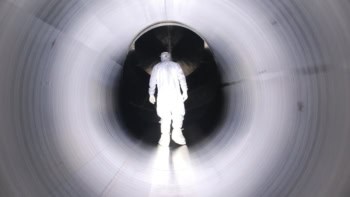
Xenon nuclei change shape as they collide, transforming from soft, oval-shaped particles to rigid, spherical ones. This finding, which is based on simulations of experiments at CERN’s Large Hadron Collider (LHC), provides a first look at how the shapes of atomic nuclei respond to extreme conditions. While the technique is still at the theoretical stage, physicists at the Niels Bohr Institute (NBI) in Denmark and Peking University in China say that ultra-relativistic nuclear collisions at the LHC could allow for the first experimental observations of these so-called nuclear shape phase transitions.
The nucleus of an atom is made up of protons and neutrons, which are collectively known as nucleons. Like electrons, nucleons exist in different energy levels, or shells. To minimize the energy of the system, these shells take different shapes, with possibilities including pear, spherical, oval or peanut-shell-like formations. These shapes affect many properties of the atomic nucleus as well as nuclear processes such as the strong interactions between protons and neutrons. Being able to identify them is thus very useful for predicting how nuclei will behave.
Colliding pairs of 129Xe atoms at the LHC
In the new work, a team led by You Zhou at the NBI and Huichao Song at Peking University studied xenon-129 (129Xe). This isotope has 54 protons and 75 neutrons and is considered a relatively large atom, making its nuclear shape easier, in principle, to study than that of smaller atoms.
Usually, the nucleus of xenon-129 is oval-shaped (technically, it is a 𝛾-soft rotor). However, low-energy nuclear theory predicts that it can transition to a spherical, prolate or oblate shape under certain conditions. “We propose that to probe this change (called a shape phase transition), we could collide pairs of 129Xe atoms at the LHC and use the information we obtain to extract the geometry and shape of the initial colliding nuclei,” Zhou explains. “Probing these initial conditions would then reveal the shape of the 129Xe atoms after they had collided.”
A quark-gluon plasma
To test the viability of such experiments, the researchers simulated accelerating atoms to near relativistic speeds, equivalent to the energies involved in a typical particle-physics experiment at the LHC. At these energies, when nuclei collide with each other, their constituent protons and neutrons break down into smaller particles. These smaller particles are mainly quarks and gluons, and together they form a quark-gluon plasma, which is a liquid with virtually no viscosity.
Zhou, Song and colleagues modelled the properties of this “almost perfect” liquid using an advanced hydrodynamic model they developed called IBBE-VISHNU. According to these analyses, the Xe nuclei go from being soft and oval-shaped to rigid and spherical as they collide.
Studying shape transitions was not initially part of the researchers’ plan. The original aim of their work was to study conditions that prevailed in the first 10-6 seconds after the Big Bang, when the very early universe is thought to have been filled with a quark-gluon plasma of the type produced at the LHC. But after they realized that their simulations could shed light on a different topic, they shifted course.
“Our new study was initiated to address the open question of how nuclear shape transitions manifest in high-energy collisions,” Zhou explains, “and we also wanted to provide experimental insights into existing theoretical nuclear structure predictions.”

Nuclear shapes revealed in high-energy collisions
One of the team’s greatest difficulties lay in developing the complex models required to account for nuclear deformation and probe the structure of xenon and its fluctuations, Zhou tells Physics World. “There was also a need for compelling new observables that allow for a direct probe of the shape of the colliding nuclei,” he says.
Applications in both high- and low-energy nuclear and structure physics
The work could advance our understanding of fundamental nuclear properties and the operation of the theory of quantum chromodynamics (QCD) under extreme conditions, Zhou adds. “The insights gleaned from this work could guide future nuclear collision experiments and influence our understanding of nuclear phase transitions, with applications extending to both high-energy nuclear physics and low-energy nuclear structure physics,” he says.
The NBI/Peking University researchers say that future experiments could validate the nuclear shape phase transitions they observed in their simulations. Expanding the study to other nuclei that could be collided at the LHC is also on the cards, says Zhou. “This could deepen our understanding of nuclear structure at ultra-short timescales of 10-24 seconds.”
The research is published in Physical Review Letters.



